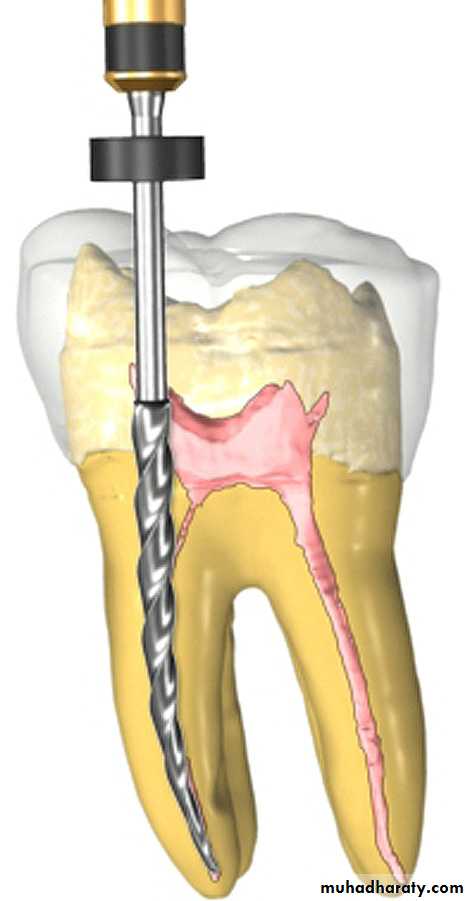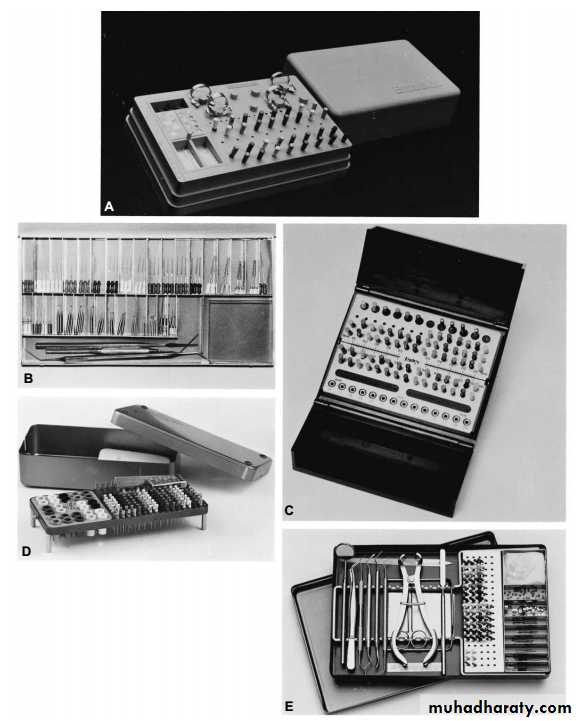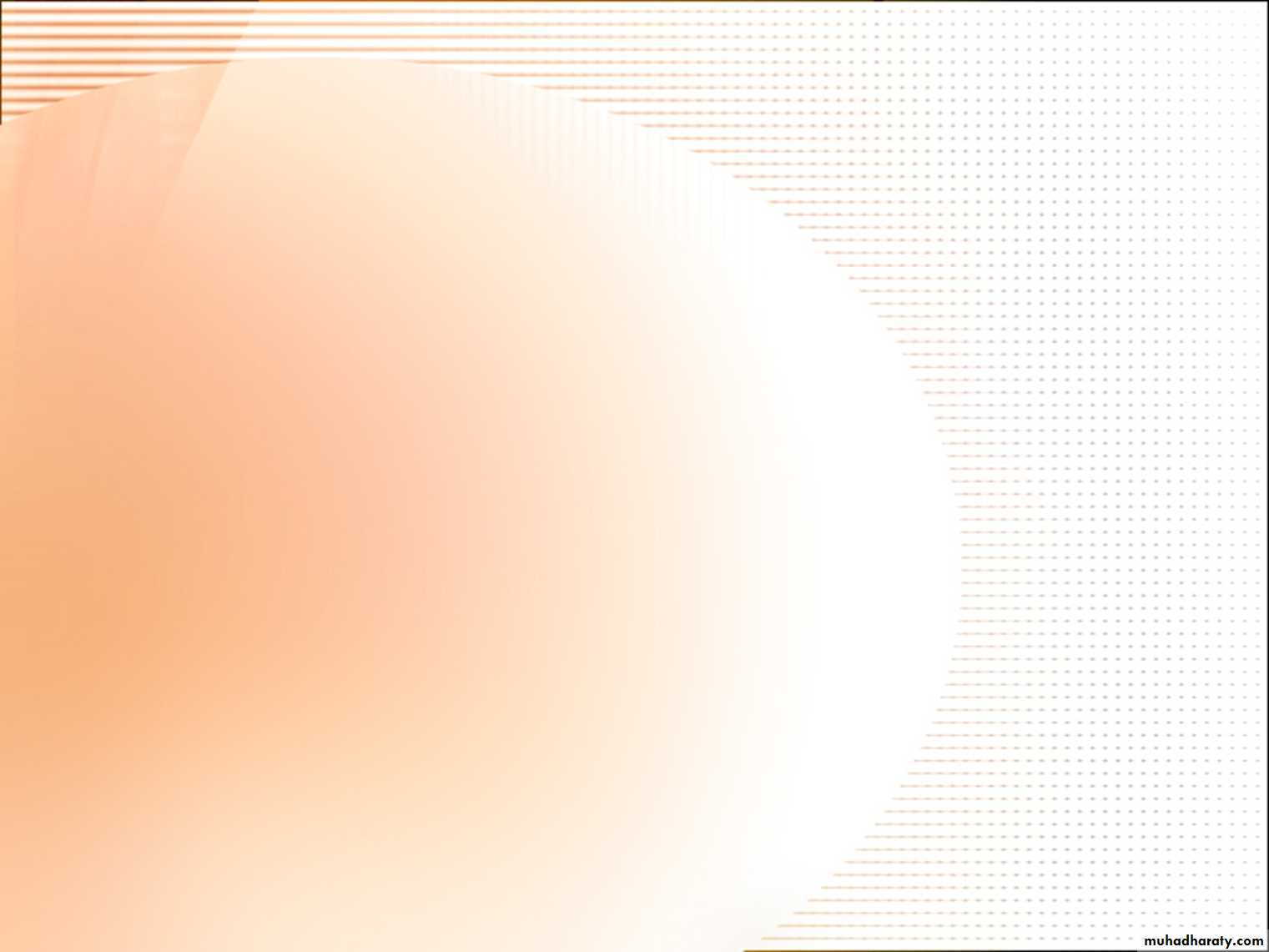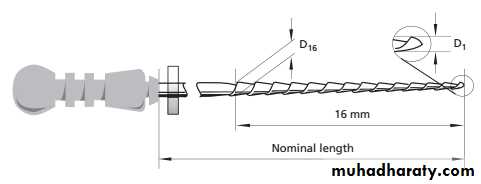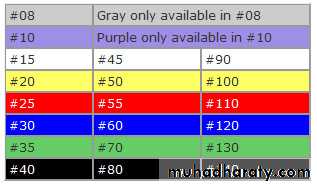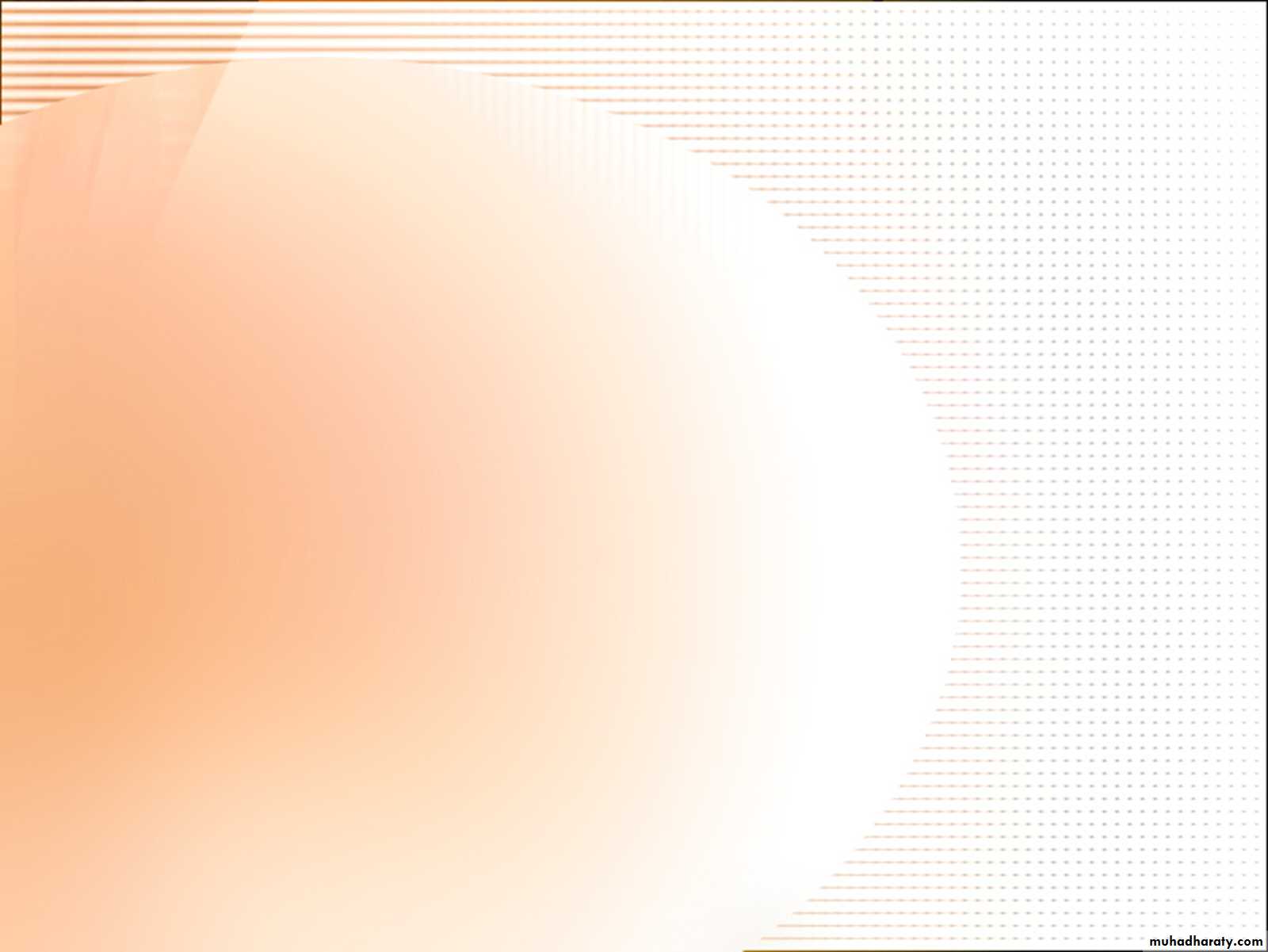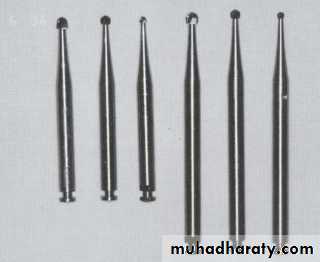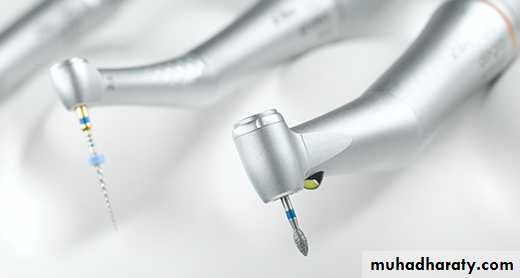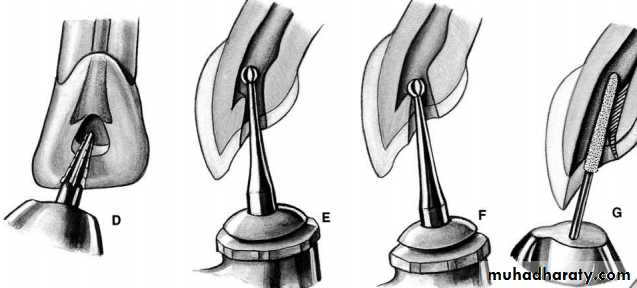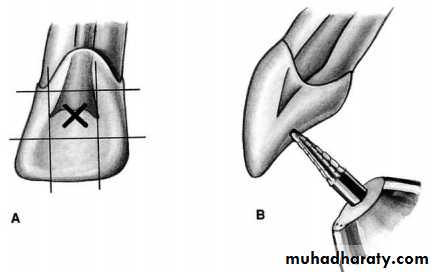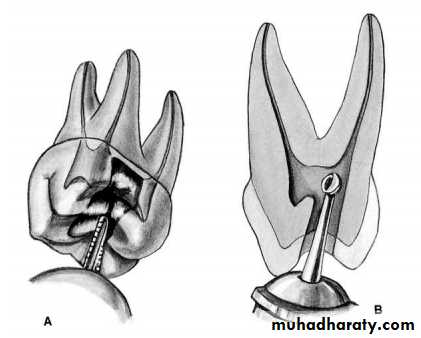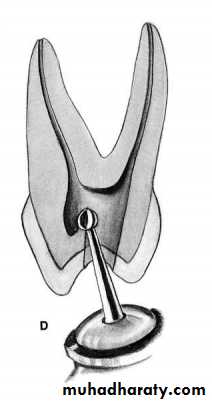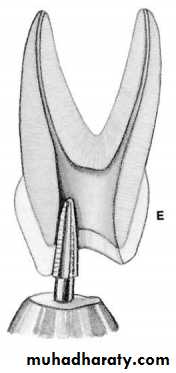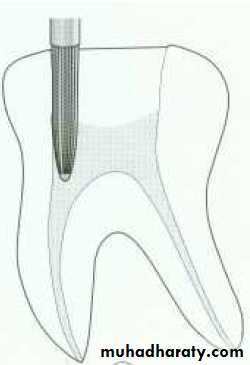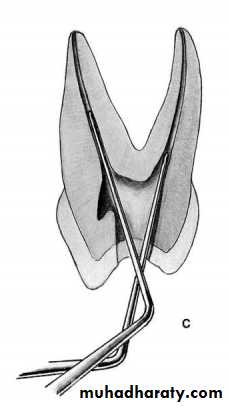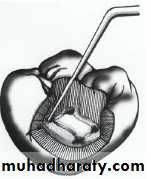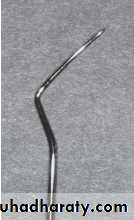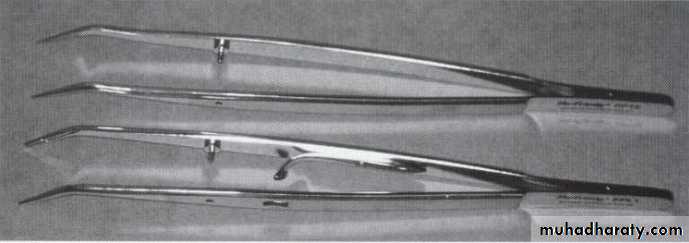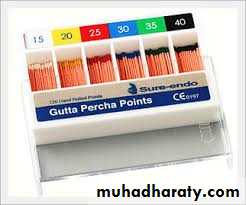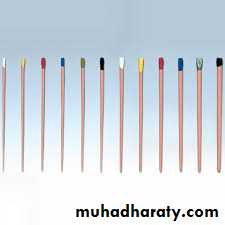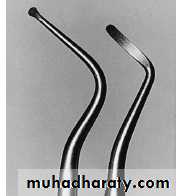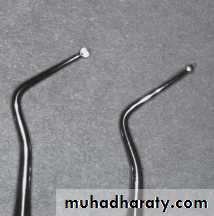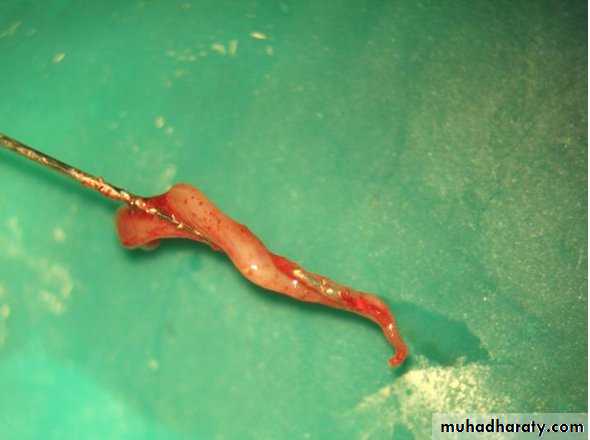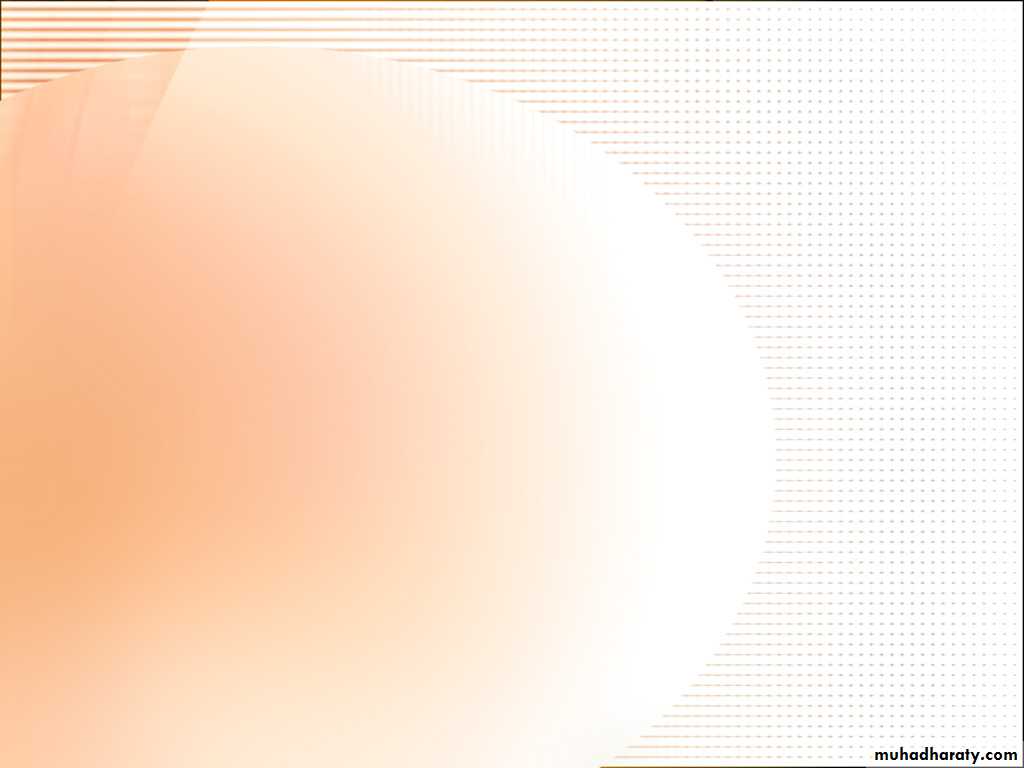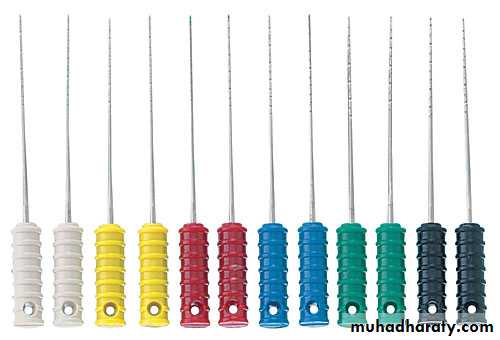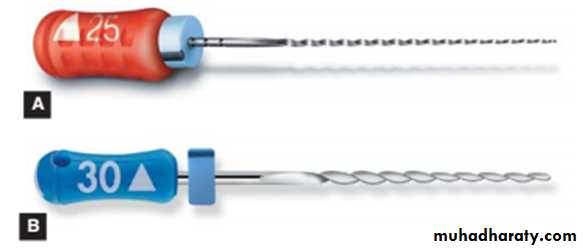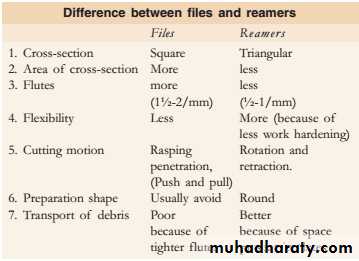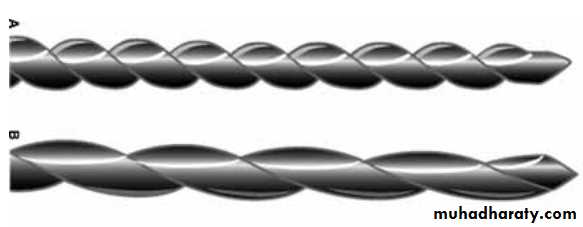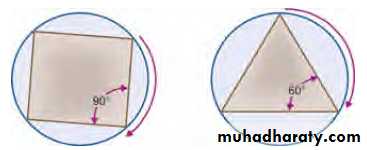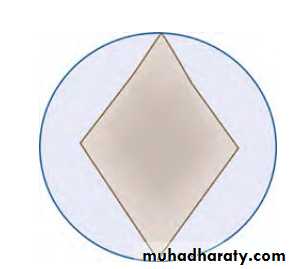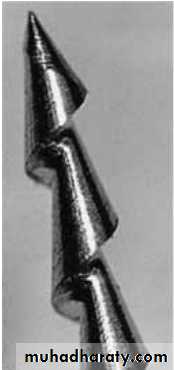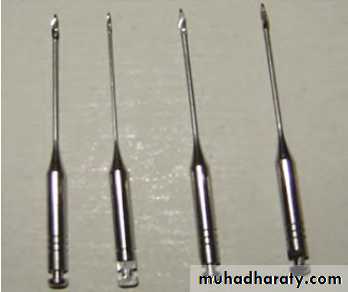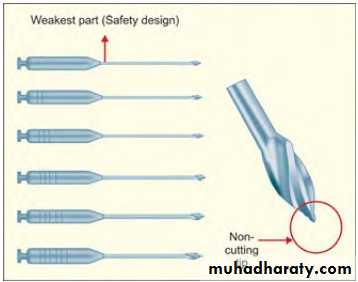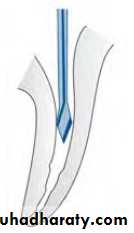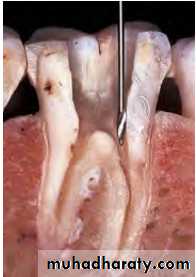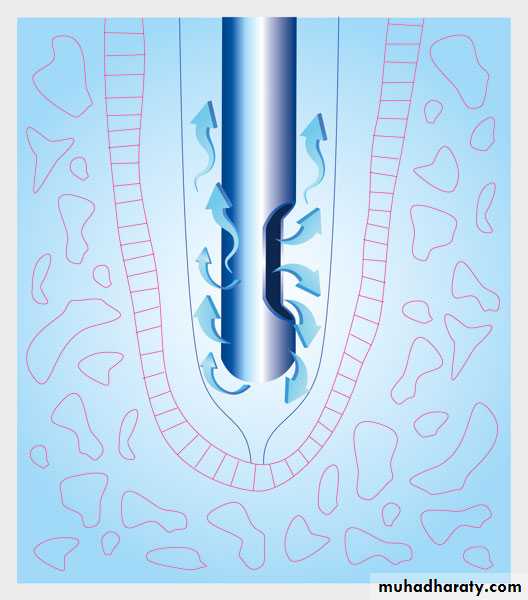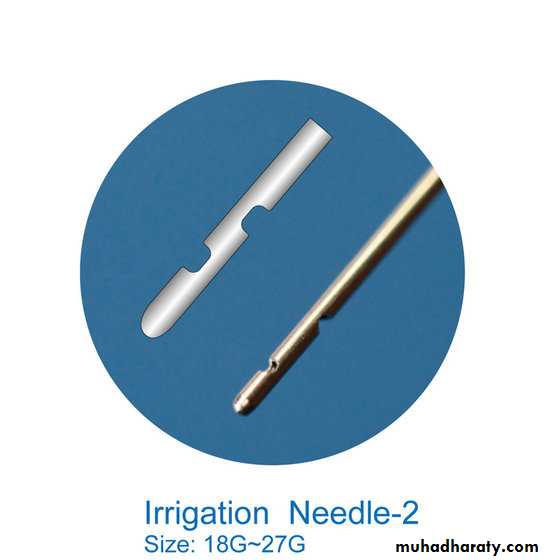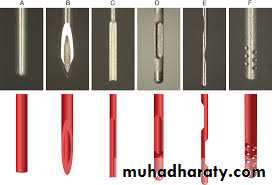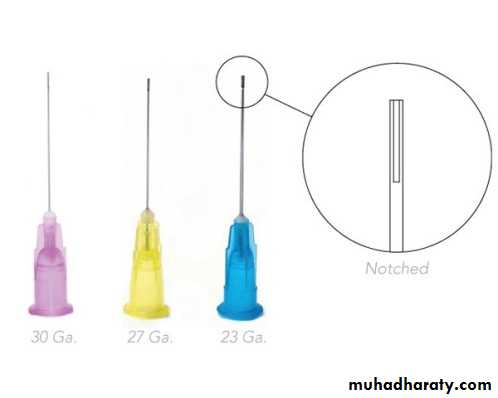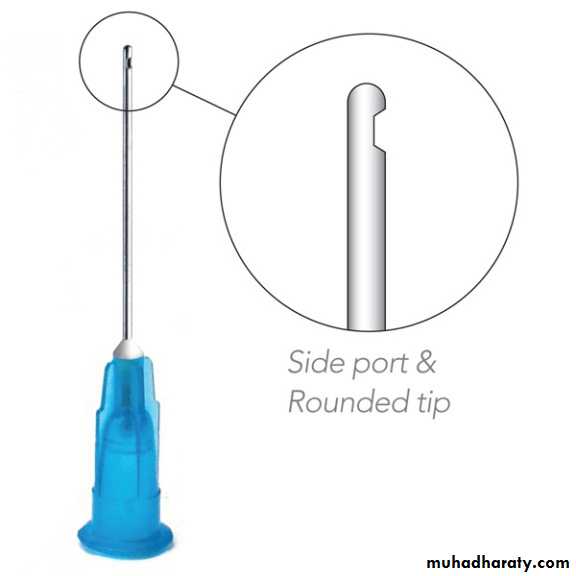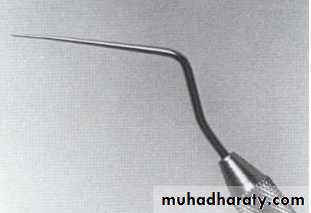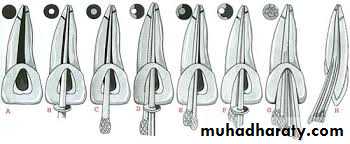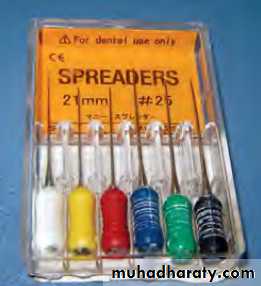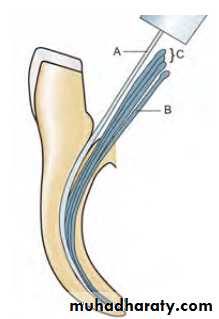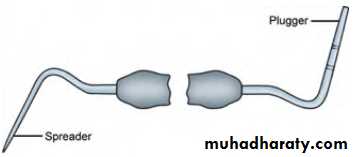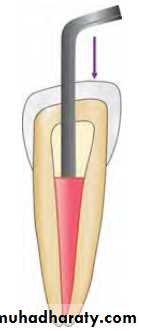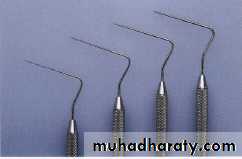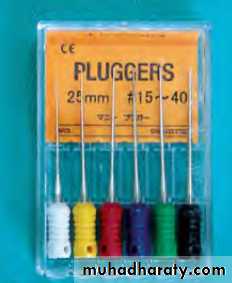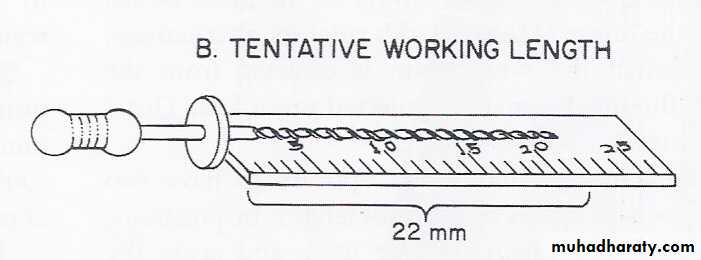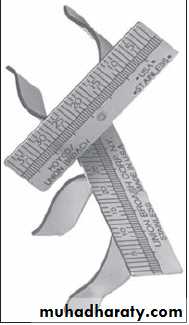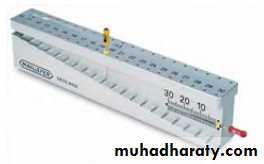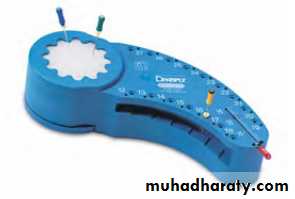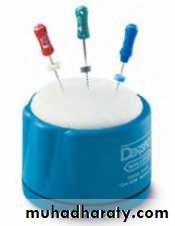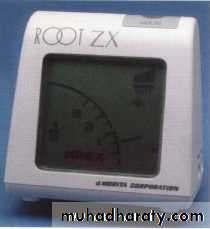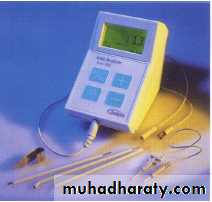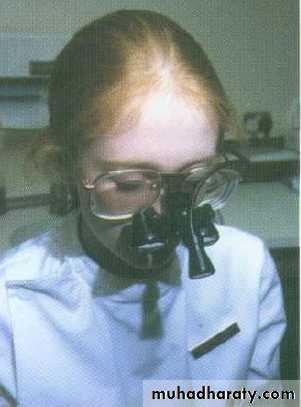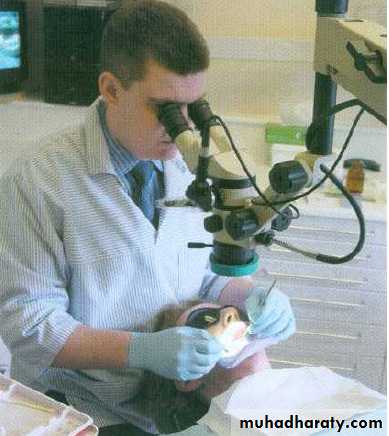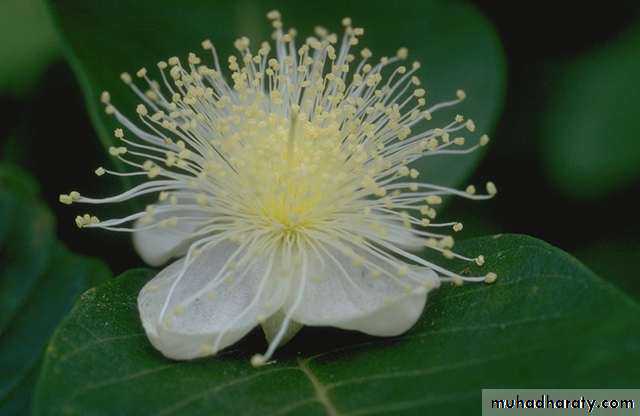بسم الله الرحمن الرحيم
ENDODONTICS
Assist prof. Dr.Emad Farhan AlkhalidiB.D.S., M.Sc., PhD.
Conservative Department
Endodontic Instruments
Endodontic Instruments
Dr.Emad Farhan Alkhalidi
B.D.S., M.Sc., PhD.
Introduction
Although most instruments used in general dentistry also can be used for endodontic therapy, some hand instruments are designed specifically for endodontic procedures.In addition, many different types of instruments have been designed for procedures performed inside the pulp space. These include manually operated instruments, rotary and other engine-driven instruments for root canal preparation, and instruments for root canal obturation.
Dr.Emad Farhan Alkhalidi
B.D.S., M.Sc., PhD.
CLASSIFICATION OF ENDODONTICINSTRUMENTS
ISO - FDI (Federation Dentaire International) :grouped rootcanal instruments according to their method of use:Group I : Hand type for example, K and H-files, reamers,broaches, etc.Group II : Latch type Engine driven: Same design as groupI but can be attached to handpiece.Group III : Drills or reamers latch type engine driven forexample, Gates-Glidden, Peeso reamers.Group IV : Root canal points like gutta-percha, silver point,paper point.Dr.Emad Farhan Alkhalidi
B.D.S., M.Sc., PhD.
Grossman’s ClassificationFunction of Instruments:Exploring: Smooth broaches and endodontic explorers. (To locate canal orifices and determine patency of root canal)Dibriding or extirpating: Barbed broaches (To extirpate the pulp and other foreign materials from the root canal)Cleaning and shaping: Reamers and files (used to shape thecanal space)Obturating: Pluggers, spreaders and lentulo spirals(To pack gutta-percha points into the root canal space).
Dr.Emad Farhan Alkhalidi
B.D.S., M.Sc., PhD.
Alloys Used for Manufacturing Endodontic Instruments
a. Carbon steelb. Stainless steelc. Nickle-titanium .a. Carbon steel: These alloys contain less-than 2.1 percent of carbon.Advantage: They have high hardness than stainless steel instruments.Disadvantages• Prone to corrosion, so cannot be resterilized• Prone to rust.Example: Barbed broach.b. Stainless steel instrumentsThese are corrosion resistant instruments. They contain 18 percent chromium, 8-10 percent nickel and 0.12 percent carbon.Advantage: Corrosion resistantDisadvantages:• Stiff in nature• Prone to fracture• Prone to distortionExample: K-file, H-file, reamerc. Nickel titaniumThese instruments contain 55 percent nickel and 45 percent titanium. Advantages:• Shape memory• Super elasticity• Low modulus of elasticity• Corrosion resistant• Softer• Good resiliency• BiocompatibilityDisadvantages of NiTi files• Poor cutting efficiency.• NiTi files do not show signs of fatigue before they fracture.• Poor resistance to fracture as compared to stainless steel.
Manufacturing of Hand InstrumentsA hand operated instrument reamer or file begins as a roundwire which is modified to form a tapered instrument with cutting edges. These are manufactured by two techniques:
a. By machining the instrument directly on the lathe forexample H-file and NiTi instruments are machined.
b. By first grinding and then twisting. Here the raw wire isground into tapered geometric blanks, i.e. square, triangularor rhomboid. These blanks are then twisted counterclockwiseto produce cutting edges.
Dr.Emad Farhan Alkhalidi
B.D.S., M.Sc., PhD.
Standardization of Endodontic Instruments• Instruments are numbered from 10-140. There is increase in (5) units up to size 60 and in (10) units till size 140.• Each number should represent diameter of instrument in 100th of millimeter at the tip.• Working blade shall begin at tip (D1) and extend 16 mm up the shaft (D2). D2 should be 0.32 mm greater than D1, ensuring that there is constant increase in taper, i.e 0.02 mm per mm of instrument. The nickel titanium rotary instruments have other variable tapers of 0.04 and 0.06. For every millimeter of length, the diameter increases by 0.04 or 0.06 mm. These greater tapers make these more aggressive in creating marked flaring preparation.• Instruments are available in following lengths: 21, 25, and 31 mm. Shorter instruments afford improved operator control and easier access to posterior teeth, to which limited opening impairs access. The 25- and 31-mm instruments are used for longer roots.
• Instruments handles should be color coded for their easier recognition (Pink, grey, purple, white, yellow, red, blue, green, black………….)
Instrument s for access cavity preparation
Turbine, Handpiece and bursDr.Emad Farhan Alkhalidi
B.D.S., M.Sc., PhD.Name
Burs
Function
several types of burs will be used to accomplish good access preparation. Fissure burs are used in the initial stage of access preparation to establish the correct outline form ,Round burs are used to lift the roof of the pulp chamber and eliminate overhanging dentine ,Tapered Non end-cutting bur is used to 'lift lid' of pulp chamber and refine cavity.
root canal explorer
Nameprobe/root canal explorer
Function
Used to probe and detect canal openings within the
pulp chamber
Endodontic plier:
Non locking and locking pliers for gutta-percha and absorbent points. The working part has grooves for holding of points.endodontic spoon excavator
Function
"larger than conventional excavator" its shape allows curettage of the pulp chamber when conventional one will not reach the floor of the chamber, and used as surgical aid to excavate periapical lesion.Instruments for root canal preparation
Extirpation Instrument
NameBarbed broaches
:Functions
1- Used to remove the intact pulp
2-Retrieve a paper point or cotton pellet trapped in the canal
• ‘Barbs’ on the broach snag the pulp to facilitate removal
• Broach does not cut the dentin
• Broach should not be forced apically into the canal.
The braded broach comes in different sizes, and the selection of suitable size is very important, it should fit loosely inside the canal, when braded broach size is larger than the canal size, the hooks of B.B engaged in the dentinal wall of the canal and stick there "Jammed broach" and with drawing it becomes difficult and might fracture inside the canal, if the dentist faced by Jammed broach, the broach should be removed vertically without twisting. The B.B must only be used in the straight part of the canal.
Reamers1. Reamers are K-type instruments (manufactured by Kerr company), which are used to ream the canals. They cut by inserting into the canal, twisting clockwise one quarter to half turn and then withdrawing, i.e.penetration, rotation and retraction.2. Reamers have triangular blank and lesser number of flutes than files
• Files
Files are the instruments used during cleaning and shaping of the root canals for machining of the dentin. Since Kerr manufacturing company was first to produce them, the files were also called K-files.Files are predominantly used with filing or rasping action in which there is little or no rotation in the root canals. It is placed in root canal and pressure is exerted against the canal wall and instrument is withdrawn while maintaining the pressure
Though reamer has fewer numbers of flutes than file, cutting efficiency is same as that of files because more space between flutes causes better removal of debris.
Reamer tends to remain self centered in the canal resulting in less chances of canal transportation.
Types of files
1- K-files• They are triangular, square or rhomboidal in cross-section, manufactured from stainless steel
wire, which is grounded into desired shape.• Tighter twisting of the file spirals increases the number of flutes in files (more than reamer).• Triangular cross-sectioned files show superior
cutting and increased flexibility than the file or reamers with square blank
2- K-flex Files
• It was realized that square blank of file results in total decrease in the instrument flexibility. To maintain shape and flexibility of these files, K-flex files were introduced.• K-flex files are rhombus in cross section having two acute angles and two obtuse angles.• Two acute angles increase sharpness and cutting efficiency of the instrument.• Two obtuse angles provide more space for debris removal. Also the decrease in contact of instrument with canal walls provide more space for irrigation.• They are used in filing and rasping motion.3- Hedstrom Files (H-files)
• Hedstrom files have flutes which resemble successively triangles set one on another.
• They are made by cutting the spiral grooves into round, tapered steel wire in the same manner as wood screws are made.
• Hedstrom files cut only when instrument is withdrawn because its edges face the handle of the instrument.• When used in torquing motion, their edges can engage in the dentin of root canal wall and causing H - files to fracture.
• Hedstrom files should be used to machine straight canals because they are strong and aggressive cutters. Since they lack the flexibility and are fragile in nature, the H-files tend to
fracture when used in torquing action.
ENGINE DRIVEN INSTRUMENTS1- Gates-Glidden Burs
• Traditional engine driven instruments include Gates-Glidden drills which have flame-shaped cutting point mounted on long thin shaft attached to a latch type shank.• Gates-Gliddens are available in a set from 1 to 6 with thediameters from 0.5 to 1.5 mm.• Due to their design Gates-Glidden drills are side cuttinginstruments with safety tips.• They should be used at the speed of 750-1500 rpm. in brushing strokes.• Safety design of Gates-Gliddens is that its weakest part lies at the junction of shank and shaft of the instrument. If its cutting tip jams against the canal wall, fracture occurs at the junction of shank and the shaft but not at the tip of the instrument. This makes the easy removal of fractured drill from the canal.
Uses of Gates-Glidden Drills1. For coronal flaring during root canal preparation2. During retreatment cases or post space preparation for removal of gutta-percha.3. Widen the canal when an instrument has fractured within it.
If used incorrectly, for example using at high rpm, incorrect angle of insertion, forceful drilling, the use of Gates-Glidden can result in procedural accidents like perforations, instrument separation.
2- PEESO REAMERS• They are rotary instruments used mainly for post space preparations.• They have safe ended non-cutting tip.
• Their tip diameter varies from 0.7 to 1.7 mm.• They should be used in brushing motion.
Disadvantages of using peeso reamers are:1. They do not follow the canal curvature and may cause perforation by cutting laterally.2. They are stiff instruments.3. They have to be used very carefully to avoid iatrogenic errors.
Disposable irrigating syringe and disposable needle
Instruments used for root canal Filling
Spreaders and pluggersAre the instruments used to compact the gutta-percha into root canal during obturationA- Hand Spreaders• They are made from stainless steel and are designed tofacilitate the placement of accessory gutta-percha pointsaround the master cone during lateral compaction technique• These spreaders do not have standardized size and shape.• They are not used routinely because excessive pressure onthe root may cause fracture of root.
B- Finger Spreaders
• They are shorter in length which allows them to afford a great degree of tactile sense and allow them to rotate freely around their axis.• They are standardized and color coded to match the size of gutta-percha points.• They can be manufactured from stainless steel or nickel titanium• Stainless steel spreaders may pose difficulty in penetration in curved canals, may cause wedging and root fracture if forced during compaction. They also produce great stresses while compaction.• NiTi spreaders are recently introduced spreaders which can penetrate the curved canals and produce less stresses during compaction. They may bend under pressure during compaction.
Pluggers
A- Hand Pluggers• They consist of diameter larger than spreader and have blunt end .• They are used to compact the warm gutta-percha verticallyand laterally into the root canal.• They may also be used to carry small segments of guttapercha into the canal during sectional filling technique.• Calcium hydroxide or MTA like materials may also be packedinto the canals using pluggers.B- Finger Pluggers
• They are used for vertical compaction of gutta-percha. They apply controlled pressure while compaction, and have more tactile sensitivity than hand plugger.Care should be taken with spreaders and pluggers while compacting the gutta-percha in canals. They should be cleaned prior to their insertion into the canal; otherwise the set sealer from previous insertion may roughen their surface and may pull the cone outside the canal rather than packing it. Also one should discard the instrument when it has become bent or screwed to avoid instrument separation while compaction.
Lentulo spiral
• They are used for applying sealer to the root canal walls before obturation.• They can be used as hand or rotary instruments.Endodontic ruler
Used for measuring the length of instrumentsEndodontic block or Transfer sponge
used to organize and hold endodontic finger and rotary instruments during procedures;• Reduces the possibility of percutaneous injuries when handling endodontic finger and rotary instruments
Electronic Apex Locators
• An electronic instrument used to determine the distance to the apical foramen
• The screen allows the operator to visualize the file movement during instrumentation
Operating loupes and microscopes
Illumination and magnification are vital for the location of root canals. The endodontist would use a surgical microscope while a general dental practitioner might have loupes and a headlight that give excellent magnification and illumination.
Thank You



